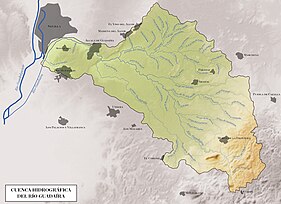Guadaira
The Guadaíra is a river in the south of the Iberian Peninsula, a tributary of the Guadalquivir and belonging to the hydrographic basin of the same name. It flows through the Spanish provinces of Cádiz and Seville. Its primitive name in the Tartessian language was Ira, probably derived from the term IR whose meaning is river in numerous paleo-Hispanic languages. This is where a pre-Roman city located in Mesa de Gandul (Alcalá de Guadaíra) took its name, called Irippo ('the city of the river').
Geography
Its source is in the province of Cádiz, in the Pozo Amargo mountain range, within the municipality of Puerto Serrano, but after a few kilometers it borders the Esparteros mountain range (Morón de la Frontera), running through almost the entire river through the province of Seville, until it empties into the Guadalquivir river, some twenty kilometers south of the city of Seville.
Its hydrographic basin extends through the municipalities of Morón de la Frontera, Marchena, Utrera, Paradas, Arahal, Mairena del Alcor, El Viso del Alcor, Alcalá de Guadaíra, Seville and others.
Its main tributaries are the Guadairilla, Alameda, Salado and Saladillo rivers, which form a subparallel dendritic network with little branching. Next to the river Genil, it is the strongest hydrographic feature in the landscape of the Sevillian countryside. The most characteristic thing about this river is the abundance of flour mills or mills that mark its course, an abundance that makes it unique in Andalusia.
There were many olive industries that were supplied with it for the preparation of olive oil and other products derived from the olive tree, which for many years caused the pollution of the river to be very important, because the olive companies did not treat its waters correctly residuals for their return to the river.
As it passes through the town of Alcalá de Guadaíra, on its shores, there are about twenty Arab mills that were used to grind wheat. And this fact facilitated the location of numerous bakeries that made bread of the highest quality. quality; the municipality became known as "Alcalá de los panaderos". There is also a Roman-style bridge, remodeled in the time of King Carlos III, over the river as it passes through this town. This space has been declared a Ribera del Guadaíra natural monument and has a very important cultural and natural heritage that can be discovered thanks to its network of trails and the Center for Education for Sustainable Tourism, a museum to learn about the values of the region.
Pollution
Since January 2010, the contamination of the Guadaíra river has taken a spectacular turnaround due to the installation of treatment plants in each and every one of the municipalities that discharge into the basin and the construction of large evaporation ponds by the businessmen in the table olive sector.
The Guadaíra has been reputed to be one of the most polluted rivers in Spain. At present it is no longer so, based on the registered values of the parameters that measure pollution. Since the last treatment plant came into operation, in Morón de la Frontera, the registered values of dissolved oxygen, organic load and nutrients are below the values established in the Water Framework Directive.
The uniqueness of the Guadaíra is manifested in the high levels of natural conductivity that the river incorporates due to the composition of the headwaters of the basin.
Contenido relacionado
Shallows
Armorers
Anvil rack








